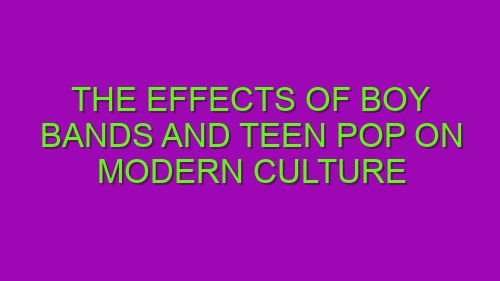-
Table of Contents
The Influence of Boy Bands and Teen Pop on Fashion Trends
The influence of boy bands and teen pop on modern culture is undeniable. From their catchy tunes to their synchronized dance moves, these musical groups have captured the hearts of millions of fans around the world. But their impact goes beyond just the music. Boy bands and teen pop have also had a significant influence on fashion trends.
One of the most notable ways in which boy bands and teen pop have influenced fashion is through their signature style. Take, for example, the iconic looks of groups like *NSYNC and the Backstreet Boys in the late 90s. These bands popularized the trend of wearing matching outfits, often consisting of oversized cargo pants, baggy shirts, and chunky sneakers. This coordinated look quickly became a fashion statement among their fans, who sought to emulate their favorite band members’ style.
In addition to their coordinated outfits, boy bands and teen pop stars have also popularized specific fashion accessories. For instance, during the height of their popularity, bands like One Direction and Big Time Rush were known for their love of snapback hats. Fans quickly caught on to this trend and started wearing snapbacks as a way to show their support for their favorite bands. Similarly, bands like the Jonas Brothers and 5 Seconds of Summer popularized the trend of wearing wristbands and bracelets, which became must-have accessories for many teenagers.
Furthermore, boy bands and teen pop stars have also influenced hairstyles. Justin Bieber’s signature swoop haircut became a global phenomenon, with fans rushing to salons to get the same look. Similarly, bands like BTS and EXO have popularized the trend of dyeing hair in vibrant colors, inspiring fans to experiment with their own hair color. These hairstyles have become a way for fans to express their admiration for their favorite artists and to feel connected to the boy band and teen pop culture.
The influence of boy bands and teen pop on fashion trends extends beyond just their fans. Designers and fashion brands have also taken note of the impact these musical groups have had on popular culture. Many fashion houses have collaborated with boy bands and teen pop stars to create limited-edition clothing lines. These collaborations not only generate excitement among fans but also help to bridge the gap between music and fashion.
Moreover, the influence of boy bands and teen pop on fashion trends can be seen on the runway. Designers often draw inspiration from the style of these musical groups, incorporating elements such as oversized silhouettes, streetwear aesthetics, and bold prints into their collections. This fusion of music and fashion has resulted in a new wave of trends that resonate with a younger audience.
In conclusion, boy bands and teen pop have had a significant influence on fashion trends. Their signature style, fashion accessories, and hairstyles have become iconic symbols of their music and have been emulated by fans around the world. Furthermore, their impact on fashion extends beyond just their fans, with designers and fashion brands recognizing the power of their influence. The fusion of music and fashion has created a cultural phenomenon that continues to shape modern culture.
The Impact of Boy Bands and Teen Pop on Social Media and Fan Culture
The Impact of Boy Bands and Teen Pop on Social Media and Fan Culture
In today’s digital age, the influence of boy bands and teen pop on social media and fan culture cannot be underestimated. With the rise of platforms like Twitter, Instagram, and TikTok, fans now have unprecedented access to their favorite artists, and boy bands and teen pop stars have capitalized on this to create a strong and dedicated fan base.
One of the most significant effects of boy bands and teen pop on social media is the way it has transformed the relationship between artists and their fans. In the past, fans had limited opportunities to interact with their idols, often relying on fan clubs or attending concerts to feel connected. However, social media has changed the game entirely. Artists can now directly communicate with their fans, sharing personal updates, behind-the-scenes content, and even responding to fan messages. This level of accessibility has fostered a sense of intimacy and connection between artists and fans that was previously unimaginable.
Social media has also given rise to a new form of fan culture, with fans forming online communities centered around their favorite boy bands and teen pop stars. These communities provide a space for fans to connect, share their love for the artists, and even collaborate on fan projects. From fan art to fan fiction, these communities have become a hub of creativity and expression. Moreover, social media has allowed fans to organize events such as fan meet-ups and charity drives, further strengthening the bond between fans and their idols.
Another significant impact of boy bands and teen pop on social media is the way it has influenced the music industry itself. Social media platforms have become a powerful tool for artists to promote their music, build anticipation for new releases, and engage with their audience. Artists can now release teasers, music videos, and exclusive content directly to their fans, creating a buzz and generating excitement. This direct connection with fans has also allowed artists to receive instant feedback on their work, helping them refine their craft and cater to their audience’s preferences.
Furthermore, social media has played a crucial role in the success of boy bands and teen pop stars. The viral nature of platforms like TikTok has allowed songs and dances to spread like wildfire, propelling artists to stardom overnight. The ability to create trends and challenges has become a powerful marketing tool, with fans and influencers alike participating and sharing content related to their favorite artists. This level of engagement has not only boosted the popularity of boy bands and teen pop stars but has also helped them reach a global audience.
However, it is important to acknowledge that the impact of boy bands and teen pop on social media is not without its drawbacks. The intense scrutiny and pressure that comes with fame can take a toll on young artists’ mental health. The constant need to maintain a perfect image and the relentless criticism from online trolls can be overwhelming. It is crucial for artists, their management teams, and fans to prioritize mental well-being and create a supportive environment.
In conclusion, boy bands and teen pop stars have had a profound impact on social media and fan culture. The accessibility and direct connection between artists and fans have transformed the relationship, fostering a sense of intimacy and community. Social media has also become a powerful tool for artists to promote their music and engage with their audience. However, it is essential to navigate the challenges that come with fame responsibly and prioritize the well-being of artists.
The Evolution of Boy Bands and Teen Pop: From the 90s to Today
The 90s marked the rise of boy bands and teen pop, a phenomenon that would have a lasting impact on modern culture. From the Backstreet Boys to NSYNC, these groups captured the hearts of millions of teenagers around the world. Their catchy tunes, synchronized dance moves, and boy-next-door charm made them instant sensations. But how did boy bands and teen pop evolve from the 90s to today?
In the 90s, boy bands dominated the music scene. The Backstreet Boys, with their harmonious vocals and infectious melodies, became a global sensation. Their success paved the way for other groups like NSYNC, 98 Degrees, and Boyzone. These bands not only captured the hearts of teenage girls but also became cultural icons. Their music videos were eagerly awaited and their concerts sold out within minutes.
As the new millennium approached, boy bands started to fade from the spotlight. However, the influence of teen pop continued to grow. Artists like Britney Spears, Christina Aguilera, and Jessica Simpson emerged as solo stars, but their music still carried the essence of the boy band era. These artists embraced a more mature image and explored themes of love, heartbreak, and empowerment in their songs.
In the late 2000s, a new wave of boy bands emerged, bringing back the nostalgia of the 90s. Groups like One Direction and The Wanted captured the attention of a new generation of fans. Social media played a crucial role in their success, allowing fans to connect with them on a more personal level. These bands not only had catchy songs but also became fashion icons, influencing the style choices of teenagers worldwide.
Today, boy bands and teen pop continue to thrive. Artists like BTS, a South Korean group, have taken the world by storm, breaking language barriers and topping charts globally. Their success can be attributed to their unique blend of pop, hip-hop, and R&B, as well as their strong social media presence. BTS has become a cultural phenomenon, with fans known as the “BTS Army” passionately supporting them.
The evolution of boy bands and teen pop reflects the changing tastes and preferences of the audience. In the 90s, boy bands were seen as wholesome and relatable, appealing to teenagers who were looking for an escape from the pressures of adolescence. As the years went by, the genre evolved to reflect the changing times. Artists like Justin Bieber and Shawn Mendes emerged as solo stars, combining elements of pop, R&B, and hip-hop in their music.
The impact of boy bands and teen pop goes beyond just the music industry. They have influenced fashion trends, hairstyles, and even the way teenagers communicate with each other. The rise of social media has allowed fans to connect with their favorite artists in ways that were unimaginable in the past. This connection has created a sense of community among fans, fostering a supportive and inclusive environment.
In conclusion, the evolution of boy bands and teen pop from the 90s to today has had a profound impact on modern culture. These groups have not only provided catchy tunes and entertaining performances but have also shaped the way teenagers express themselves and connect with others. As the genre continues to evolve, it will be interesting to see how boy bands and teen pop will continue to influence and inspire future generations.



















